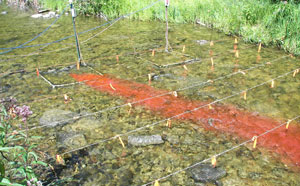Ancient Lamprey DNA decoded
In the current issue of Nature Genetics, a team of scientists has presented an assembly of the sea lamprey genome - the first time the entire sequence has been decoded.

When it comes to evolution, humans can learn a thing or two from primeval sea lampreys.
In the current issue of Nature Genetics, a team of scientists has presented an assembly of the sea lamprey genome – the first time the entire sequence has been decoded. The data is compelling as the sea lamprey is one of the few ancient, jawless species that has survived through the modern era.
The paper not only sheds light on how the venerable invasive species adapted and thrived, but it also provides many insights into the evolution of all vertebrates, species with backbones and spinal cords, which includes humans, said Weiming Li, Michigan State University fisheries and wildlife professor and AgBioResearch scientist, who organized and coordinated the team.
“Sea lampreys are amazing survivors,” said Li, whose teammate, Jeramiah Smith of the University of Kentucky, led the analysis of the genome assembly. “Even though they diverged from our lineage 500 million years ago, they give us a template of how vertebrates, including humans, evolved into the modern species that we have today.”
By serving as a bridge to bygone eras, lamprey DNA also provides pathways to many extinct lineages, thus opening the door to decode many prehistoric species, he added.
Based on fossil records, the Cambrian period is cited as a dramatic time when life exploded from single-celled organisms to complex, multicelled creatures. During this time, many species developed jaws and skeletal frames that protected their brain, spine and nervous system. Some, in fact, even had brains that shared the same basic structures and functions as modern humans.
By mapping the sea lamprey genome, scientists may soon better understand how and when humans evolved. Future studies also could answer when humans evolved jaws, matching arms and legs, an adaptive immune system and more.
 But understanding sea lampreys to better understand them is beneficiary in its own right. They are an invasive species that feed by attaching themselves to other fish, such as salmon and trout. One sea lamprey can kill more than 40 pounds of fish, and the U.S. and Canadian governments spend $10 to $15 million annually to control them in the Great Lakes.
But understanding sea lampreys to better understand them is beneficiary in its own right. They are an invasive species that feed by attaching themselves to other fish, such as salmon and trout. One sea lamprey can kill more than 40 pounds of fish, and the U.S. and Canadian governments spend $10 to $15 million annually to control them in the Great Lakes.
The team’s research could eventually reveal new and better ways to limit the destruction sea lampreys cause.
Additional MSU team members include Yu-Wen Chung-Davidson, Kaben Nanlohy, Scot Libants, Chu-Yin Yeh and Titus Brown.
Li’s lamprey genome research is funded primarily by the National Human Genome Research Institute and the Great Lakes Fishery Commission. In addition, his work is funded in part by the National Science Foundation and MSU AgBioResearch.



 Print
Print Email
Email




